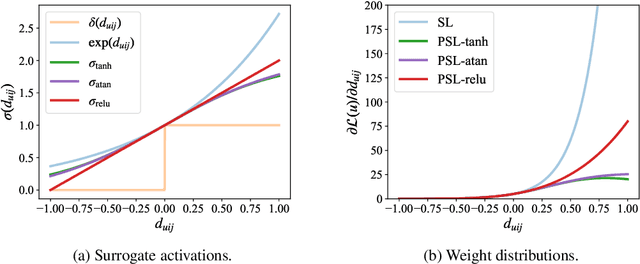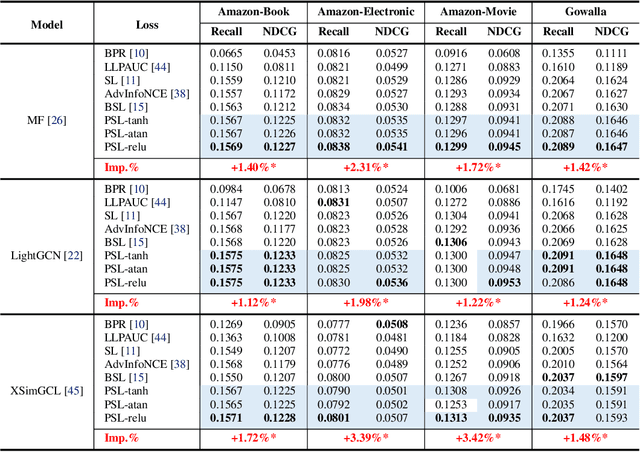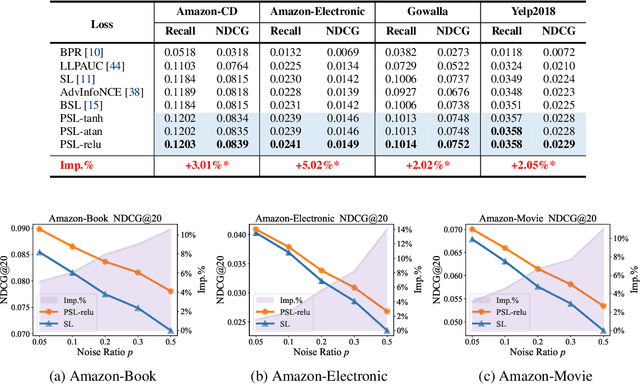Chun Chen
Advancing Loss Functions in Recommender Systems: A Comparative Study with a Rényi Divergence-Based Solution
Jun 18, 2025Abstract:Loss functions play a pivotal role in optimizing recommendation models. Among various loss functions, Softmax Loss (SL) and Cosine Contrastive Loss (CCL) are particularly effective. Their theoretical connections and differences warrant in-depth exploration. This work conducts comprehensive analyses of these losses, yielding significant insights: 1) Common strengths -- both can be viewed as augmentations of traditional losses with Distributional Robust Optimization (DRO), enhancing robustness to distributional shifts; 2) Respective limitations -- stemming from their use of different distribution distance metrics in DRO optimization, SL exhibits high sensitivity to false negative instances, whereas CCL suffers from low data utilization. To address these limitations, this work proposes a new loss function, DrRL, which generalizes SL and CCL by leveraging R\'enyi-divergence in DRO optimization. DrRL incorporates the advantageous structures of both SL and CCL, and can be demonstrated to effectively mitigate their limitations. Extensive experiments have been conducted to validate the superiority of DrRL on both recommendation accuracy and robustness.
GUI-Robust: A Comprehensive Dataset for Testing GUI Agent Robustness in Real-World Anomalies
Jun 17, 2025Abstract:The development of high-quality datasets is crucial for benchmarking and advancing research in Graphical User Interface (GUI) agents. Despite their importance, existing datasets are often constructed under idealized conditions, overlooking the diverse anomalies frequently encountered in real-world deployments. To address this limitation, we introduce GUI-Robust, a novel dataset designed for comprehensive GUI agent evaluation, explicitly incorporating seven common types of anomalies observed in everyday GUI interactions. Furthermore, we propose a semi-automated dataset construction paradigm that collects user action sequences from natural interactions via RPA tools and then generate corresponding step and task descriptions for these actions with the assistance of MLLMs. This paradigm significantly reduces annotation time cost by a factor of over 19 times. Finally, we assess state-of-the-art GUI agents using the GUI-Robust dataset, revealing their substantial performance degradation in abnormal scenarios. We anticipate that our work will highlight the importance of robustness in GUI agents and inspires more future research in this direction. The dataset and code are available at https://github.com/chessbean1/GUI-Robust..
DualBreach: Efficient Dual-Jailbreaking via Target-Driven Initialization and Multi-Target Optimization
Apr 21, 2025Abstract:Recent research has focused on exploring the vulnerabilities of Large Language Models (LLMs), aiming to elicit harmful and/or sensitive content from LLMs. However, due to the insufficient research on dual-jailbreaking -- attacks targeting both LLMs and Guardrails, the effectiveness of existing attacks is limited when attempting to bypass safety-aligned LLMs shielded by guardrails. Therefore, in this paper, we propose DualBreach, a target-driven framework for dual-jailbreaking. DualBreach employs a Target-driven Initialization (TDI) strategy to dynamically construct initial prompts, combined with a Multi-Target Optimization (MTO) method that utilizes approximate gradients to jointly adapt the prompts across guardrails and LLMs, which can simultaneously save the number of queries and achieve a high dual-jailbreaking success rate. For black-box guardrails, DualBreach either employs a powerful open-sourced guardrail or imitates the target black-box guardrail by training a proxy model, to incorporate guardrails into the MTO process. We demonstrate the effectiveness of DualBreach in dual-jailbreaking scenarios through extensive evaluation on several widely-used datasets. Experimental results indicate that DualBreach outperforms state-of-the-art methods with fewer queries, achieving significantly higher success rates across all settings. More specifically, DualBreach achieves an average dual-jailbreaking success rate of 93.67% against GPT-4 with Llama-Guard-3 protection, whereas the best success rate achieved by other methods is 88.33%. Moreover, DualBreach only uses an average of 1.77 queries per successful dual-jailbreak, outperforming other state-of-the-art methods. For the purpose of defense, we propose an XGBoost-based ensemble defensive mechanism named EGuard, which integrates the strengths of multiple guardrails, demonstrating superior performance compared with Llama-Guard-3.
ControlNET: A Firewall for RAG-based LLM System
Apr 13, 2025Abstract:Retrieval-Augmented Generation (RAG) has significantly enhanced the factual accuracy and domain adaptability of Large Language Models (LLMs). This advancement has enabled their widespread deployment across sensitive domains such as healthcare, finance, and enterprise applications. RAG mitigates hallucinations by integrating external knowledge, yet introduces privacy risk and security risk, notably data breaching risk and data poisoning risk. While recent studies have explored prompt injection and poisoning attacks, there remains a significant gap in comprehensive research on controlling inbound and outbound query flows to mitigate these threats. In this paper, we propose an AI firewall, ControlNET, designed to safeguard RAG-based LLM systems from these vulnerabilities. ControlNET controls query flows by leveraging activation shift phenomena to detect adversarial queries and mitigate their impact through semantic divergence. We conduct comprehensive experiments on four different benchmark datasets including Msmarco, HotpotQA, FinQA, and MedicalSys using state-of-the-art open source LLMs (Llama3, Vicuna, and Mistral). Our results demonstrate that ControlNET achieves over 0.909 AUROC in detecting and mitigating security threats while preserving system harmlessness. Overall, ControlNET offers an effective, robust, harmless defense mechanism, marking a significant advancement toward the secure deployment of RAG-based LLM systems.
MSL: Not All Tokens Are What You Need for Tuning LLM as a Recommender
Apr 05, 2025Abstract:Large language models (LLMs), known for their comprehension capabilities and extensive knowledge, have been increasingly applied to recommendation systems (RS). Given the fundamental gap between the mechanism of LLMs and the requirement of RS, researchers have focused on fine-tuning LLMs with recommendation-specific data to enhance their performance. Language Modeling Loss (LML), originally designed for language generation tasks, is commonly adopted. However, we identify two critical limitations of LML: 1) it exhibits significant divergence from the recommendation objective; 2) it erroneously treats all fictitious item descriptions as negative samples, introducing misleading training signals. To address these limitations, we propose a novel Masked Softmax Loss (MSL) tailored for fine-tuning LLMs on recommendation. MSL improves LML by identifying and masking invalid tokens that could lead to fictitious item descriptions during loss computation. This strategy can effectively avoid the interference from erroneous negative signals and ensure well alignment with the recommendation objective supported by theoretical guarantees. During implementation, we identify a potential challenge related to gradient vanishing of MSL. To overcome this, we further introduce the temperature coefficient and propose an Adaptive Temperature Strategy (ATS) that adaptively adjusts the temperature without requiring extensive hyperparameter tuning. Extensive experiments conducted on four public datasets further validate the effectiveness of MSL, achieving an average improvement of 42.24% in NDCG@10. The code is available at https://github.com/WANGBohaO-jpg/MSL.
Towards Label-Only Membership Inference Attack against Pre-trained Large Language Models
Feb 26, 2025Abstract:Membership Inference Attacks (MIAs) aim to predict whether a data sample belongs to the model's training set or not. Although prior research has extensively explored MIAs in Large Language Models (LLMs), they typically require accessing to complete output logits (\ie, \textit{logits-based attacks}), which are usually not available in practice. In this paper, we study the vulnerability of pre-trained LLMs to MIAs in the \textit{label-only setting}, where the adversary can only access generated tokens (text). We first reveal that existing label-only MIAs have minor effects in attacking pre-trained LLMs, although they are highly effective in inferring fine-tuning datasets used for personalized LLMs. We find that their failure stems from two main reasons, including better generalization and overly coarse perturbation. Specifically, due to the extensive pre-training corpora and exposing each sample only a few times, LLMs exhibit minimal robustness differences between members and non-members. This makes token-level perturbations too coarse to capture such differences. To alleviate these problems, we propose \textbf{PETAL}: a label-only membership inference attack based on \textbf{PE}r-\textbf{T}oken sem\textbf{A}ntic simi\textbf{L}arity. Specifically, PETAL leverages token-level semantic similarity to approximate output probabilities and subsequently calculate the perplexity. It finally exposes membership based on the common assumption that members are `better' memorized and have smaller perplexity. We conduct extensive experiments on the WikiMIA benchmark and the more challenging MIMIR benchmark. Empirically, our PETAL performs better than the extensions of existing label-only attacks against personalized LLMs and even on par with other advanced logit-based attacks across all metrics on five prevalent open-source LLMs.
Uncertainty-Aware Graph Structure Learning
Feb 19, 2025Abstract:Graph Neural Networks (GNNs) have become a prominent approach for learning from graph-structured data. However, their effectiveness can be significantly compromised when the graph structure is suboptimal. To address this issue, Graph Structure Learning (GSL) has emerged as a promising technique that refines node connections adaptively. Nevertheless, we identify two key limitations in existing GSL methods: 1) Most methods primarily focus on node similarity to construct relationships, while overlooking the quality of node information. Blindly connecting low-quality nodes and aggregating their ambiguous information can degrade the performance of other nodes. 2) The constructed graph structures are often constrained to be symmetric, which may limit the model's flexibility and effectiveness. To overcome these limitations, we propose an Uncertainty-aware Graph Structure Learning (UnGSL) strategy. UnGSL estimates the uncertainty of node information and utilizes it to adjust the strength of directional connections, where the influence of nodes with high uncertainty is adaptively reduced. Importantly, UnGSL serves as a plug-in module that can be seamlessly integrated into existing GSL methods with minimal additional computational cost. In our experiments, we implement UnGSL into six representative GSL methods, demonstrating consistent performance improvements.
DICE: Distilling Classifier-Free Guidance into Text Embeddings
Feb 06, 2025



Abstract:Text-to-image diffusion models are capable of generating high-quality images, but these images often fail to align closely with the given text prompts. Classifier-free guidance (CFG) is a popular and effective technique for improving text-image alignment in the generative process. However, using CFG introduces significant computational overhead and deviates from the established theoretical foundations of diffusion models. In this paper, we present DIstilling CFG by enhancing text Embeddings (DICE), a novel approach that removes the reliance on CFG in the generative process while maintaining the benefits it provides. DICE distills a CFG-based text-to-image diffusion model into a CFG-free version by refining text embeddings to replicate CFG-based directions. In this way, we avoid the computational and theoretical drawbacks of CFG, enabling high-quality, well-aligned image generation at a fast sampling speed. Extensive experiments on multiple Stable Diffusion v1.5 variants, SDXL and PixArt-$\alpha$ demonstrate the effectiveness of our method. Furthermore, DICE supports negative prompts for image editing to improve image quality further. Code will be available soon.
Mitigating Privacy Risks in LLM Embeddings from Embedding Inversion
Nov 06, 2024



Abstract:Embeddings have become a cornerstone in the functionality of large language models (LLMs) due to their ability to transform text data into rich, dense numerical representations that capture semantic and syntactic properties. These embedding vector databases serve as the long-term memory of LLMs, enabling efficient handling of a wide range of natural language processing tasks. However, the surge in popularity of embedding vector databases in LLMs has been accompanied by significant concerns about privacy leakage. Embedding vector databases are particularly vulnerable to embedding inversion attacks, where adversaries can exploit the embeddings to reverse-engineer and extract sensitive information from the original text data. Existing defense mechanisms have shown limitations, often struggling to balance security with the performance of downstream tasks. To address these challenges, we introduce Eguard, a novel defense mechanism designed to mitigate embedding inversion attacks. Eguard employs a transformer-based projection network and text mutual information optimization to safeguard embeddings while preserving the utility of LLMs. Our approach significantly reduces privacy risks, protecting over 95% of tokens from inversion while maintaining high performance across downstream tasks consistent with original embeddings.
PSL: Rethinking and Improving Softmax Loss from Pairwise Perspective for Recommendation
Oct 31, 2024



Abstract:Softmax Loss (SL) is widely applied in recommender systems (RS) and has demonstrated effectiveness. This work analyzes SL from a pairwise perspective, revealing two significant limitations: 1) the relationship between SL and conventional ranking metrics like DCG is not sufficiently tight; 2) SL is highly sensitive to false negative instances. Our analysis indicates that these limitations are primarily due to the use of the exponential function. To address these issues, this work extends SL to a new family of loss functions, termed Pairwise Softmax Loss (PSL), which replaces the exponential function in SL with other appropriate activation functions. While the revision is minimal, we highlight three merits of PSL: 1) it serves as a tighter surrogate for DCG with suitable activation functions; 2) it better balances data contributions; and 3) it acts as a specific BPR loss enhanced by Distributionally Robust Optimization (DRO). We further validate the effectiveness and robustness of PSL through empirical experiments. The code is available at https://github.com/Tiny-Snow/IR-Benchmark.
 Add to Chrome
Add to Chrome Add to Firefox
Add to Firefox Add to Edge
Add to Edge